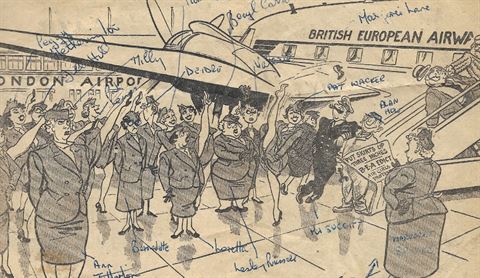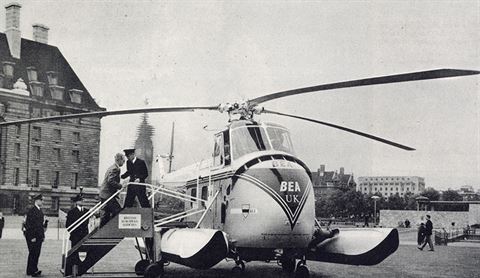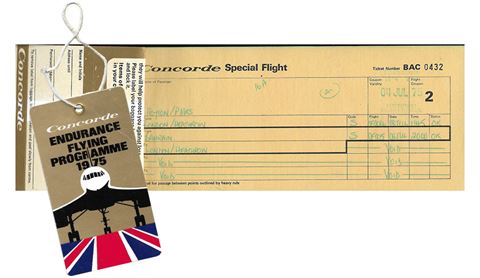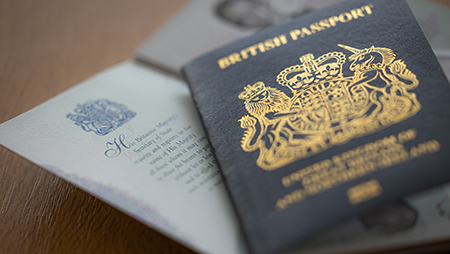July 2024
Checking in Churchill – and other stories from the golden age of travel
Ninety-year-old Patricia Peyton winds back the clock on the 28 years she spent with BEA and BOAC (now British Airways)
“‘Don’t you know who I am?’ That was a regular one,” Patricia Peyton laughs, spreading out a sheaf of delicately preserved papers – the Concorde Endurance Flying programme, worldwide flight routes, luncheon invitations from the International Air Transport Association…
All these – and more – fell into Patricia’s possession between 1953 to 1981, during her time at British European Airways (BEA), then British Overseas Airways Corporation (BOAC), where she racked up quite the CV. What started as a career in the engineering and then cargo departments soon segued to the check-in desks, before a stint in ticket reservations, revenue accounts and, eventually, a role training new staff. Patricia would go on to become the highest-ranking woman with children within BOAC at the time.
Checking in the greats
“So many of the travellers back then were well known,” she reminisces of her time on the check-in desk, between 1955 and 1961. Perhaps most famous was Sir Winston Churchill, who often travelled to Morocco or the south of France during his second premiership. “I’d always check him into the VIP lounge, hauling the heavy scales required for weighing his cases with me,” says Patricia. “He had plenty of baggage, of course, but nothing like some of the actresses. I remember telling American film star Myrna Loy she couldn’t take all three bags into the cabin!” And this is not forgetting the multiple Wimbledon stars who Patricia had to ask to purchase an extra plane ticket, should they wish to take all their racquets with them. (This is no longer the case. Find out more about taking sports equipment here.)

“...And now if there are any in favour of the proposed shorter hemline, will they kindly signify in the usual manner.”
Was Patricia in favour of a shorter skirt? Spot Pat... The Evening News, 1957
By the 1950s, the golden age of travel had well and truly arrived, with many passengers expecting white linens, five-star food and copious Champagne. “Glamour and luxury became a real selling point,” Patricia says. “Attracted to my check-in desk were the likes of pianist Arthur Rubinstein, soprano Maria Callas, actress Joan Collins and her then husband Anthony Newley and, of course, Frank Sinatra, who I checked in flying to Los Angeles via Copenhagen.” What was that like? “I was so nervous,” she confesses. “I didn’t want to label his baggage incorrectly!”
Patricia would greet passengers – some of whom had travelled to London Airport (now Heathrow) via a helicopter from what was then the London Waterloo Air Terminal – weigh and label their baggage by hand, add the flight and three letter airport code and deposit the bag on the conveyor belt ready for its journey. A passenger list was next on Patrica’s to-do list, followed by completing the ‘load sheets’ – a document critical for the aircraft’s weight and balance.
There were no allocated seats back then, either. “We’d show passengers a seating card and I’d always have men come up and say, “Can you give me the seat next to that gorgeous woman over there?” Patricia laughs. Passengers would only need 45 minutes to go through check-in and security.
“I’d always have men come up and say, “Can you give me the seat next to that gorgeous woman over there?”
The high life
The uniform of the time added to the decadence. “You had to wear your high heels from the moment you stepped out of your car,” says Patricia. “If you were found in flats you’d be in trouble!” She is quick to tell us she was, at the time, strictly eight stone, three pounds.
“Your hair and makeup were glamorous, too, weren’t they?” nudges Patricia’s granddaughter, sitting next to her as we chat over tea in High Wycombe. “Oh, it was all glamorous,” she replies. “I sometimes went on the helicopter (that transferred passengers from the terminal to Waterloo station) just to get my hair done in Baker Street. It cost half a crown!”

BEA’s Waterloo Terminal
A room of one’s own
So, how did Patricia’s journey begin? After completing a bilingual secretarial course in French, Russian and Spanish at 19, she began a temporary summer job in the personnel department at the BOAC engineering base. She was later asked to permanently join the cargo side of things, registering and clearing cargo for customs.
“I was the first woman to work in import cargo,” Patricia says, “I was – always – in a room full of men.” It was the central terminal, however, where Patricia knew she would shine. After proving herself in interviews (and through some rather determined letters to management), she started on the check-in desk one week after her 21st birthday, in May 1955.
First female trainer in BOAC history
One year after becoming a mother in 1961, Patricia headed back to work. This time, in ticket reservations on Regent Street, manually working out ticket fares and securing bookings for customers over the phone. Before long, she moved to revenue accounts, managing flight coupons for multi-airline tickets.
In 1967, Patricia went into traffic-side training, teaching new recruits her wealth of knowledge, including cargo inputs, load and passenger sheets, check-in, new routes procedure, ticket fares and more.
“Recruits came from around the world to train on my course in London,” Patricia explains. “We’d also travel to Nairobi twice a year and to Muscat. I’d often ask: if you are flying to Nairobi from Johannesburg, are you going north, south, east or west?”
This wasn’t the only geography test she’d dispense – and back then, there was no Google Maps to save the new recruits: “I’d ask them to point to LA on the map. Some were so hopeless that they’d point to Mumbai instead.” But others excelled. Only those who passed Patricia’s examinations would move up to the next level.
“By the 1970s, I was the highest paid woman at BOAC with children. I even had equal pay (which was unheard of at the time). I remember a student once wrote their dissertation about me,” Patricia reveals. When computers gradually entered the industry, Patricia trained up recruits on how to calculate fares and input cargo or load sheets using the shiny new technology. “These days, everything has changed. You check in online yourself, weigh your own bags, have your tickets on your phone – it’s really quite remarkable.”

Patricia’s ticket for a Concorde test flight
Flying at Mach 2
In July 1975, Patricia was specifically chosen to fly on the Concorde Endurance Programme, the last major phase of flight-testing Concorde had to pass before gaining its Certificate of Airworthiness. “I remember flying at 50,000 feet and gazing down upon the curvature of the earth,” she says. “It was quite something.” And while there were no films on board, the flight did feature a 12-course menu – including dishes of scallop and shrimp, fillet steak, focaccia bread, and crab and spinach salad.
We watch as Patricia finishes flicking through almost 30 years of memorabilia. She shoots a teasing look to her granddaughter. “You don’t know all my stories,” she jests. “They go on forever.”
And that we can believe.
A lifetime of service
1934: Patricia Peyton is born in Cheshire
1952: Trains as a bilingual translator at the French Institute, South Kensington
1953: Begins job in personnel department, originally only for three months in the engineering base, before staying on
1954: Joins the import cargo and transhipment booking team
1955: At the age of 21, now legally allowed to do shift work, Patricia starts on the check-in desk in the central London Airport terminal and then moves to the ticket desk
1961: Becomes a mother for the first time
1962: Enters the ticket reservations department, based in Regent Street
1964: Transfers to the revenue accounts office
1967: Becomes the first female trainer in BOAC and begins training new recruits worldwide, often travelling solo
1970s: Becomes the highest paid female in BOAC with children
1974: BOAC and BEA become British Airways
1981: Leaves British Airways after 28 years
More from previous issues

The best of BA news
A new partnership with Pasta Evangelists offers the chance to win a trip to Italy – will you be the lucky jet-setter?

How to get your group trip off the ground
From bill-splitting to people pleasing, there are ways to take the stress out of your bigger trips

The ultimate passport trivia quiz
From cartoon characters to stand-out covers – how well do you know the world’s favourite travel document?

On set with our new safety video stars
As our latest safety video gathers internet fame, The Club goes behind the scenes to meet its stars
